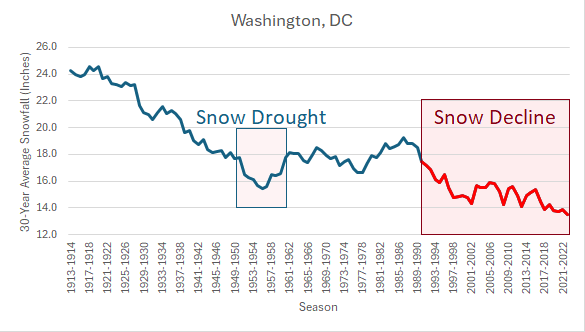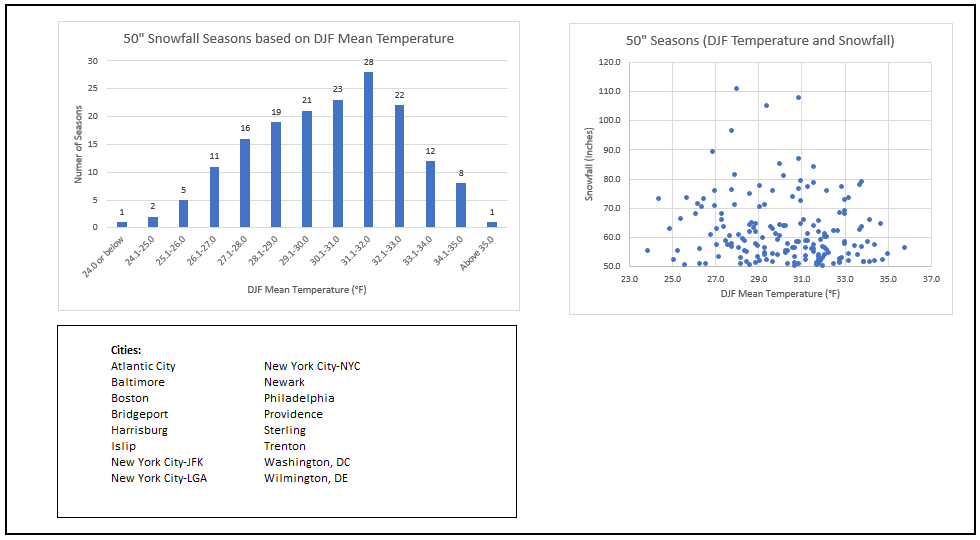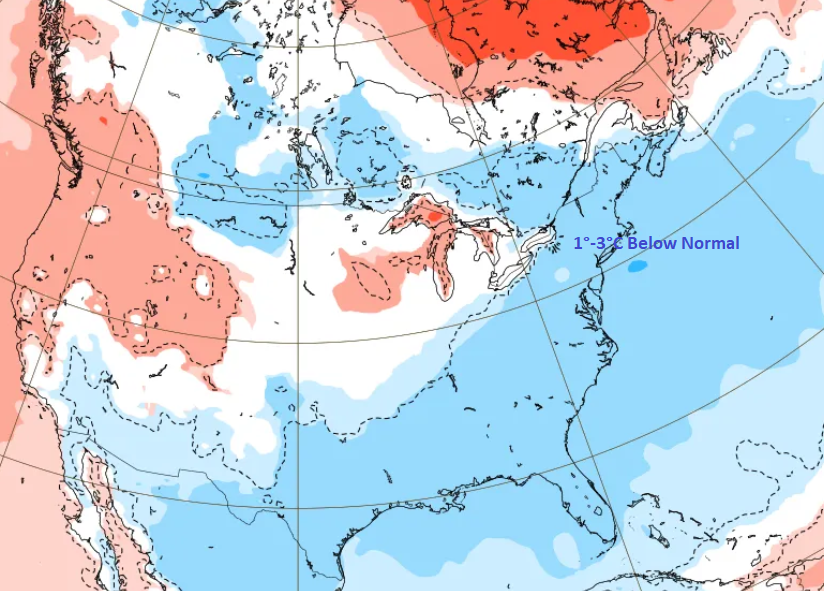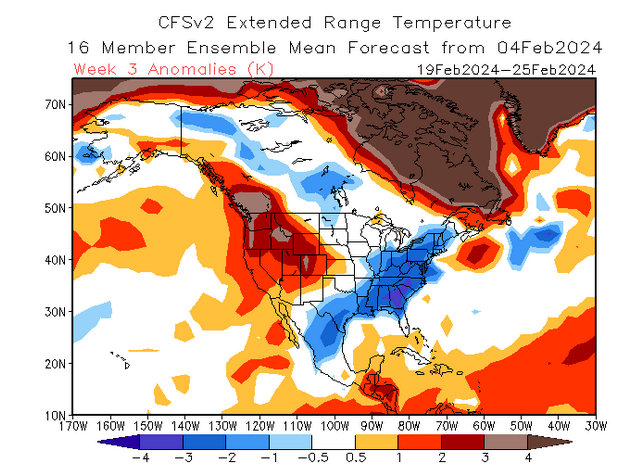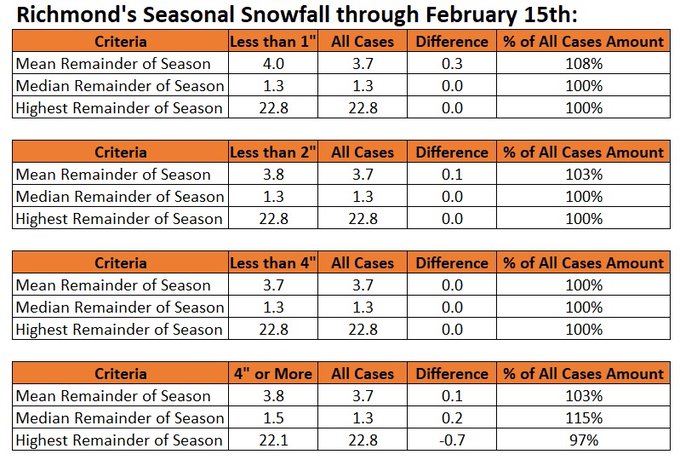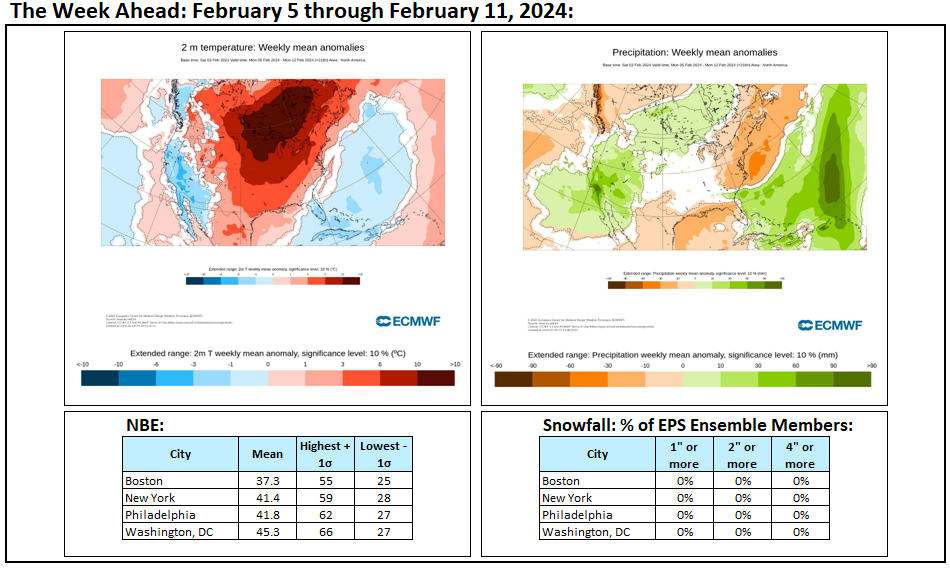-
Posts
22,983 -
Joined
Content Type
Profiles
Blogs
Forums
American Weather
Media Demo
Store
Gallery
Everything posted by donsutherland1
-
The record is 37 days (2011-12 and 2022-23).
-
The term was created by a team of MIT scientists in the 1990s. https://ny1.com/nyc/all-boroughs/ap-top-news/2024/02/01/a-look-at-atmospheric-rivers-the-long-bands-of-water-vapor-that-form-over-oceans-and-fuel-storms Their work was published in 1992: https://agupubs.onlinelibrary.wiley.com/doi/10.1029/92GL02916 They described the phenomenon as "atmospheric rivers" or "tropospheric rivers" due to the amount of water transported (often the equivalent of the Amazon River).
-
Yes, the same categories apply. The December 2023 atmospheric river was a category 5 one.
-
Atmospheric rivers are plumes of moisture that flow out of the tropics. They can occur outside of the Pacific. The East Coast had one in December. https://wapo.st/49mvHdP
-
That's a key point. For purposes of illustration, below is Washington, DC's 30-year average seasonal snowfall. The red line denotes the timing where Washington, DC's mean winter temperature reached 37 degrees and then continued to rise due to ongoing warming.
-
A life-threatening atmospheric river continues to bring heavy rain and high wind to parts of southern California. Flash flooding, mudslides, and rock slides have been reported. Through 2 pm PST, Downtown Los Angeles has picked up 6.66" of rain. That is a new 2-day February record and the third highest 2-day figure on record. Records go back to 1877. Mild conditions prevailed under abundant sunshine in the Middle Atlantic and southern New England regions. However, the seeds of change are beginning to sprout. The Arctic Oscillation has gone negative (-0.369). That is one of the pieces that will fall into place leading to a large-scale pattern change near mid-month. Tomorrow will be fair and seasonably cool. Much warmer air will then push into the region afterward. The temperature could rise into the 50s in New York City and 60s south of Philadelphia late in the week. The generally mild conditions will likely continue into at least the second week of February with only brief interruptions. No Arctic air is likely to reach the area during this time. As a result, the first 10 days of February could wind up 5°-7° above normal in New York City. Potentially, New York City could wind up with a mean temperature of 40.0° or above during the February 1-10 period. Since 1869, there have been 9 prior cases. Five have occurred since 2000 and eight have occurred since 1990: 1952, 1990, 1991, 1999, 2005, 2008, 2012, 2016, and 2020. Seven of those nine years saw less than 10" snowfall for the remainder of the season following February 10th. Only one saw more than 20.0" (22.7", 2005). The least was the trace of snow that fell in 2020. The mean snowfall was 7.2" while the median snowfall was 6.0". In short, were the February 1-10 temperature to average 40.0° or above, that development could be a reinforcing signal for a below to much below normal snowfall season. The second week of February will likely see the evolution toward a sustained colder pattern begin late that week. Overall, February will likely wind up warmer than normal, even as the second half of the month could see a sustained period of colder weather. Single-digit cold is unlikely in New York City. During February, cases with warm ENSO Region 1+2 anomalies see such lows at 55% of frequency as cold ENSO Region 1+2 cases during El Niño winters. During the second half of February, just 17% of cases with a PDO- saw single-digit cold during El Niño winters. January saw a strongly negative PDO. The ENSO Region 1+2 anomaly was +1.0°C and the Region 3.4 anomaly was +1.8°C for the week centered around January 31. For the past six weeks, the ENSO Region 1+2 anomaly has averaged +0.87°C and the ENSO Region 3.4 anomaly has averaged +1.83°C. A basinwide El Niño event is ongoing. The ongoing El Niño event will continue to fade through much of February. The SOI was -36.41 today. The preliminary Arctic Oscillation (AO) was -0.369 today. On February 3 the MJO was in Phase 7 at an amplitude of 1.954 (RMM). The February 2-adjusted amplitude was 1.964 (RMM).
-
Since their respective periods of record began, here's the distribution of 50" or above snow seasons by winter (December-February) mean temperature for select Mid-Atlantic and southern New England cities. I used the numbers from Washington, DC to Boston (n=171 such seasons). Warmer cities such as Annapolis, Norfolk, and Richmond have never had such seasons. Only Trenton (1966-67: 35.0°, 54.0") and Washington, DC (2009-10: 35.8°, 56.1") saw such seasons with winter mean temperatures of 35.0° or above. The warming climate will lead to a diminished frequency of such seasons and, in some areas, the possible disappearance of such seasons by the middle of this century.
-
The limit refers to perhaps the winter mean temperature being near the limit where 50” seasons can occur, not the amount of snowfall for a given season.
-
Such seasons will become less frequent as the warming continues to occur. 2009-10 provides perhaps an illustration of where the limits might lie. Washington, DC saw 56.1" of snow with a December-February mean temperature of 35.8°.
-
The near mid-month pattern change remains on track. Both the latest ECMWF weeklies and CFSv2 are in strong agreement concerning the February 19-25 period: ECMWF Weeklies: 1°C to 3°C below normal Note: Download issues precluded providing the full map with its corresponding temperature scale The CFSv2: In addition, the Arctic Oscillation (AO) has now gone negative. Its preliminary value for today is -0.369.
-
Only 1930-31 (6.8") had less snow through February 4th than this winter (7.3"). Winter 1930-31 finished with 14.2". Winter 2023-24 is so far the warmest on record for Minneapolis (28.7° mean temperature vs. 27.4° in 1877-78).
-
Typo: Should be 1,352. I accidentally omitted the 1000s in the first post on this matter.
-
32 days for the MJO + specified teleconnections and 352 days for all other cases.
-
For MJO Phases 1,8 (Amplitude 1.000 or above), AO-, EPO-, NAO-, PNA+: February 1975-2023 % of days: 2" or more snow: 27% 4" or more snow: 18% For all other cases: February 1975-2023: 2" or more snow: 17% 4" or more: 10%
-
-
Out West, a major rainstorm was getting underway in California. Through 5 pm EST, Santa Barbara had received 1.16" of rain, breaking the daily record of 0.50" from 1990. In the Northeast, sunshine and mild temperatures prevailed. It could turn briefly cooler for Monday and Tuesday before much warmer air pushes into the region. The temperature could exceed 50° on one or more days late in the week. The generally mild conditions will likely continue into at least the second week of February with only brief interruptions. No Arctic air is likely to reach the area during this time. As a result, the first 10 days of February could wind up 5°-7° above normal in New York City. Potentially, New York City could wind up with a mean temperature of 40.0° or above during the February 1-10 period. Since 1869, there have been 9 prior cases. Five have occurred since 2000 and eight have occurred since 1990: 1952, 1990, 1991, 1999, 2005, 2008, 2012, 2016, and 2020. Seven of those nine years saw less than 10" snowfall for the remainder of the season following February 10th. Only one saw more than 20.0" (22.7", 2005). The least was the trace of snow that fell in 2020. The mean snowfall was 7.2" while the median snowfall was 6.0". In short, were the February 1-10 temperature to average 40.0° or above, that development could be a reinforcing signal for a below to much below normal snowfall season. The second week of February will likely see the evolution toward a sustained colder pattern begin late that week. Overall, February will likely wind up warmer than normal, even as the second half of the month could see a sustained period of colder weather. Single-digit cold is unlikely in New York City. During February, cases with warm ENSO Region 1+2 anomalies see such lows at 55% of frequency as cold ENSO Region 1+2 cases during El Niño winters. During the second half of February, just 17% of cases with a PDO- saw single-digit cold during El Niño winters. January saw a strongly negative PDO. The ENSO Region 1+2 anomaly was +0.7°C and the Region 3.4 anomaly was +1.7°C for the week centered around January 24. For the past six weeks, the ENSO Region 1+2 anomaly has averaged +0.97°C and the ENSO Region 3.4 anomaly has averaged +1.87°C. A basinwide El Niño event is ongoing. The ongoing El Niño event will continue to fade through much of February. The SOI was -28.05 today. The preliminary Arctic Oscillation (AO) was +1.248 today.
-
Typo, it was a PNA+. It shows that the days with such a pattern in February are colder than climatology. Unfortunately, no such database exists for all the variables. Some of the data is revised fairly frequently. MJO phases and amplitudes, especially for recent dates, are revised every few months by the Bureau of Meteorology.
-
Richmond’s February 16 and later snowfall is less sensitive to bad starts than NYC’s, because snowfall opportunities are already more dispersed in its warmer climate.
-
No real changes from my earlier thinking concerning the forthcoming pattern change. The latest ECMWF weeklies, extended portion of the EPS, and CFSv2 weeklies all support the idea of a pattern change. As for the issue of single-digit readings, those remain very unlikely. Since 1950, there have been only two days with single digits during February 16-29 where the ENSO Region 3.4 anomaly was 0.5C or above and the PDO was negative. In contrast, there were 10 cases when the PDO was positive. The PDO remains negative. Considering the strongly negative preliminary January number, the PDO is very likely to have a negative average during February. Warm ENSO Region 1+2 cases also favor less severe cold. Snowfall prospects continue to favor lighter events. Historic climatology for winters with very low snowfall through February 15th argues strongly in favor of limiting expectations to lighter events with perhaps the possibility of a moderate 3"-4" event. Until the guidance consistently shows otherwise, that remains a reasonable course. The colder pattern could continue into the first week of March. Afterward, things become much more uncertain. I am aware of social media speculation comparing the upcoming change to February 2010. What that speculation misses is that Winter 2009-10 had already seen significant snowfall prior to February 20th (including in December) and was much colder over the December-January period than the current winter.
-
Tomorrow will be another fair and pleasant day. Temperatures will again rise to somewhat above normal levels. The dry weather will likely continue through into at least next weekend. It could turn briefly cooler early next week before much warmer air pushes into the region. The generally mild conditions will likely continue into at least the second week of February with only brief interruptions. No Arctic air is likely to reach the area during this time. As a result, the first 10 days of February could wind up 5°-7° above normal in New York City. Potentially, New York City could wind up with a mean temperature of 40.0° or above during the February 1-10 period. Since 1869, there have been 9 prior cases. Five have occurred since 2000 and eight have occurred since 1990: 1952, 1990, 1991, 1999, 2005, 2008, 2012, 2016, and 2020. Seven of those nine years saw less than 10" snowfall for the remainder of the season following February 10th. Only one saw more than 20.0" (22.7", 2005). The least was the trace of snow that fell in 2020. The mean snowfall was 7.2" while the median snowfall was 6.0". In short, this could be a reinforcing signal for a below to much below normal snowfall season. The second week of February could see the evolution toward a sustained colder pattern begin late that week. Overall, February will likely wind up warmer than normal even as the second half of the month could see a sustained period of colder weather. The ENSO Region 1+2 anomaly was +0.7°C and the Region 3.4 anomaly was +1.7°C for the week centered around January 24. For the past six weeks, the ENSO Region 1+2 anomaly has averaged +0.97°C and the ENSO Region 3.4 anomaly has averaged +1.87°C. A basinwide El Niño event is ongoing. The ongoing El Niño event will continue to fade through much of February. The SOI was -22.19 today. The preliminary Arctic Oscillation (AO) was +2.670 today. On February 1 the MJO was not available. The January 31-adjusted amplitude was 2.114 (RMM).
-
I hope MJO812 didn't just "like" this post, but is taking this matter seriously and investigating this strange phenomenon to ensure that we are all safe.
-
I will see what I can come up with tomorrow.
-
The seemingly perpetual "empire of clouds" will fall overnight as drier air overspreads the region. Sunshine, which has been a rare commodity of late, could be in abundance during the weekend. Temperatures will continue to run somewhat above normal. It could turn briefly cooler early next week before much warmer air pushes into the region. The generally mild conditions will likely continue into at least the second week of February with only brief interruptions. No Arctic air is likely to reach the area during this time. As a result, the first 10 days of February could wind up 5°-7° above normal in New York City. Potentially, New York City could wind up with a mean temperature of 40.0° or above during the February 1-10 period. Since 1869, there have been 9 prior cases. Five have occurred since 2000 and eight have occurred since 1990: 1952, 1990, 1991, 1999, 2005, 2008, 2012, 2016, and 2020. Seven of those nine years saw less than 10" snowfall for the remainder of the season following February 10th. Only one saw more than 20.0" (22.7", 2005). The least was the trace of snow that fell in 2020. The mean snowfall was 7.2" while the median snowfall was 6.0". In short, this could be a reinforcing signal for a below to much below normal snowfall season. The second week of February could see the evolution toward a sustained colder pattern begin late that week. Overall, February will likely wind up warmer than normal even as the second half of the month could see a sustained period of colder weather. The ENSO Region 1+2 anomaly was +0.7°C and the Region 3.4 anomaly was +1.7°C for the week centered around January 24. For the past six weeks, the ENSO Region 1+2 anomaly has averaged +0.97°C and the ENSO Region 3.4 anomaly has averaged +1.87°C. A basinwide El Niño event is ongoing. The ongoing El Niño event will continue to fade through much of February. The SOI was -29.40 today. The preliminary Arctic Oscillation (AO) was +3.433 today. On January 31 the MJO was in Phase 7 at an amplitude of 2.114 (RMM). The January 30-adjusted amplitude was 2.230 (RMM).





